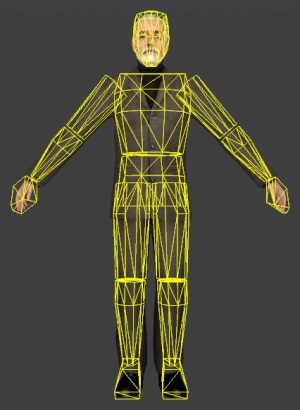VPhysics
VPhysics is ![]() Source's built-in 3D physics simulation engine. VPhysics objects move and collide believably thanks to the system's simulation of mass, gravity, friction, air resistance, inertia, and buoyancy.
Source's built-in 3D physics simulation engine. VPhysics objects move and collide believably thanks to the system's simulation of mass, gravity, friction, air resistance, inertia, and buoyancy.
VPhysics was originally created by incorporating Ipion Virtual Physics, a physics middleware acquired and since licensed by Havok (later acquired by Microsoft). The successor to VPhysics on ![]() Source 2 is Rubikon.
Source 2 is Rubikon.
x86_64 beta branch only, which backported changes from CS:GO VPhysics) ships with more optimized VPhysics (used in all Source games since Left 4 Dead), compiled using floats instead of doubles, which was meant to improve performance on console (Xbox 360 and PlayStation 3) and lower end hardware, as well to reduce network prediction errors and servers CPU usage. However, this leads to unreliable collision detection due to reduced physics precision. This means in some cases props and other physics objects will briefly glitch through map object, other props or other physics objects. See issue #7426 on GitHub. The fix is currently being tested (available as double-physics-test beta branch) as of November 2025. (tested in: All games on Collision Models

VPhysics objects ("collision models") are invisible, because in order for the simulation to be efficient they must be extremely simple. The visible part of an entity will obviously be a close match to the shape of the VPhysics object, but it is entirely ignored by the simulator.
Collision models are typically loaded from a collision mesh embedded inside an entity's assigned model, but they can also be generated, from a bounding box for instance. Spherical collision models are also possible.
vcollide_wireframe 1.QPhysics
VPhysics co-exists with QPhysics (a retroactive name—it's only ever referred to in the codebase as "game physics"), an older and far less sophisticated simulator that Source inherits from ![]() Quake II. QPhysics is still used for players and walking NPCs because full VPhysics would lead to situations too complex for either AI or players to handle. Vehicles and flying NPCs like npc_manhack do use VPhysics, however. Most moving brush entities (func_rotating, func_movelinear, func_tracktrain etc) also use QPhysics to move.
Quake II. QPhysics is still used for players and walking NPCs because full VPhysics would lead to situations too complex for either AI or players to handle. Vehicles and flying NPCs like npc_manhack do use VPhysics, however. Most moving brush entities (func_rotating, func_movelinear, func_tracktrain etc) also use QPhysics to move.
QPhysics entities are given a VPhysics "shadow" that allows them to interact with VPhysics entities in a limited way. They can push around physics objects, and be an anchor for physics constraints, but cannot be influenced the other way around. Some brush entities can be temporarily blocked by physics objects.
Brush entities use a combination of axial and planar brushsides for QPhysics collision, and point entities use axial bounding boxes or hitboxes. Rotating QPhysics collision will cause it to subtly break, such as making surfing impossible.
Programming
In programming terms, VPhysics is an engine library that takes direct control of the motion of an entity. When it is in full effect QPhysics positioning functions cease to have any effect, and the object's behaviour is instead influenced through the application of forces and constraints (though direct modification is still possible).
This spawn function creates a physically-simulated model:
#define MODEL "models/props_c17/FurnitureDresser001a.mdl"
void CMyEnt::Spawn()
{
PrecacheModel(MODEL);
SetModel(MODEL);
VPhysicsInitNormal(SOLID_VPHYSICS,0,false);
}
There initialisation functions are:
VPhysicsInitNormal- Used above. Makes the entity a free VPhysics object with full simulation and collisions.
VPhysicsInitStatic()- An object that never moves.
VPhysicsInitShadow( bool allowPhysicsMovement, bool allowPhysicsRotation, solid_t *pSolid = 0 )- An object that collides with other VPhysics objects, but has its location defined by the QPhysics motion of its entity. This can lead to very strong forces being exerted on normal VPhysics objects, so use with care!
Unlike VPhysicsInitNormal(), neither of the functions above implicitly call SetSolid(). You will need to do so yourself as the default SOLID_NONE causes both to return early.
SetSolid() alone does not enable VPhysics collisions.Units
| Measurement | Unit |
|---|---|
| Distance | Inches |
| Mass | Kilogrammes |
| Volume | Cubic inches |
| Velocity | Inches per second |
| Acceleration | Inches per second per second |
| Density | Kilogrammes per cubic metre |
| Force | Inches per second per kilogramme |
| Torque | Degrees per second per kilogramme |
Structures
IPhysicsEnvironment- A VPhysics environment within which objects are simulated. New
IPhysicsObjects are created here, and global settings like gravity can be configured. IPhysicsEnvironment* physenvis created by default. Multiple environments are entirely possible, which is how Portal and
Portal and  Portal 2 work.
Portal 2 work.- IPhysicsObject
- The core interface into a VPhysics object. Provides functions for tweaking parameters and applying forces. An entity can have multiple
IPhysicsObjects (e.g. ragdolls). IPhysicsCollision- Provides various
CPhysCollideandCPhysConvex(see below) utilities. Use thephyscollisionglobal instance. CPhysCollide- A rigid collision mesh. Despite being named like a server entity, this class is defined in the engine. It can be passed to various
IPhysicsCollisionfunctions. vcollide_t- A collection of
CPhysCollides. CPhysConvex- A single, convex collision mesh element.
CPhysPolysoup- A collection of raw polygons that represent a collision mesh. Call
physcollision->ConvertPolysoupToCollide()to "compile" it to aCPhysCollide. solid_t- A collection of data passed to the engine when creating new physics objects.